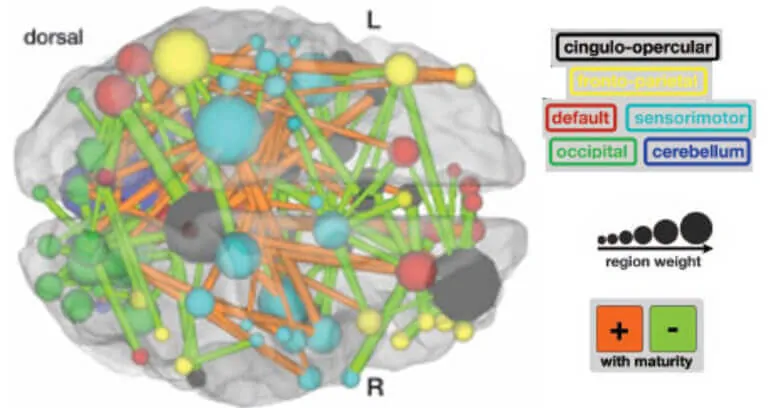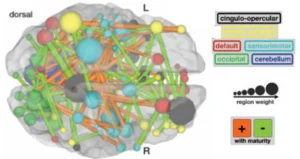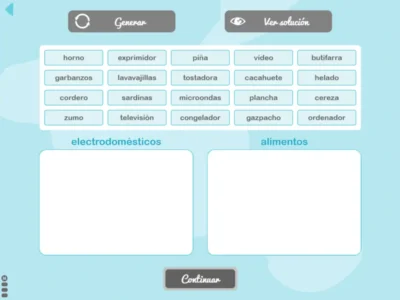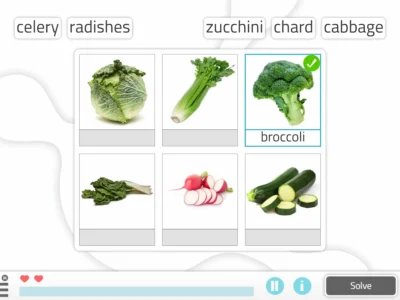This article presents brief anatomical foundations of attention and an overview of the main nodes involved in the attentional process and how they operate.
“Attention is the selection of information for conscious processing and action, as well as the maintenance of the level of alertness required for attentive processing.
(Posner and Bourke, 1999)
Fundamental concepts of attention
Posner (1995) identifies three fundamental concepts of attention:
- Attention does not process information; it only makes that processing possible or inhibits it. Attention can be anatomically distinguished from information-processing systems.
- Attention is supported by anatomical networks, it does not belong to a specific brain region nor is it a global product of the brain.
- Brain areas involved in attention do not have the same function, but different functions are supported by different areas. This is not a unitary function.
This is very important, as it allows distinguishing the attentional processing system from the perceptual processing system, among others, which is highly relevant from an evaluative perspective.
Attention, therefore, has two main functions: maintaining the state of alertness (VIGILANCE) and selecting the information to which resources will be devoted (MONITORING AND CONTROL). It selects the mechanisms and the information that will be manipulated. The attentional system has limited capacity, hence it needs to select the type of relevant information.
Attentional systems
Posner distinguishes three attentional systems:
- Ascending reticular system: Responsible for tone tasks, regulation of wakefulness states and the autonomic state for functioning. Its main nuclei are located in the brainstem, although its networks extend via ascending pathways throughout the brain. Its main neurotransmitter is norepinephrine (NE). The main NE inputs from the locus coeruleus are the parietal area, the pulvinar nucleus of the thalamus and the colliculi, i.e., the areas that make up the posterior attentional network.
- Posterior attentional system: This network is related to the visuo-spatial orienting of attention, which is why it has also been called the orienting network. The term orienting refers to overt alignment (of the sensory organs) or covert alignment (of attention) with a source of sensory information or with a memory content. Orienting can be exogenous or respond to internal elements.
- Anterior attentional system: Carries out functions of selection and stimulus discrimination and error detection.
The activity of the systems is not independent per se, but depends on the attentional demands of the task.
Attentional system in Posner’s theory
For Benedet (2002), the attentional system in Posner’s theory involves:
- Maintaining the necessary level of alertness at all times,
- detecting infrequent stimulus changes (vigilance),
- selecting relevant information (selective attention) and inhibiting irrelevant information (resistance to distraction),
- maintaining that selective function during the execution of an activity or task of some duration (sustained attention),
- evaluating the state of the system at all times (monitoring),
- optimally distributing resources among the different representations and operations that are activated (distributed attention).
Improving Posner’s model
Some authors, although partially agreeing with Posner, extend his attentional model. Dosenbach, Fair, Cohen, Schlaggar & Petersen (2008) state that in the study of attention and especially of the attentional control network, there are various analytical methods to draw conclusions about the connectivity of attentional networks. These methods limit the scope of conclusions if used separately or together.
They do not deny Posner’s initial proposal, since there are a series of attentional networks with different purposes; although their results support a redefinition of the attentional control system. To this end, Dosenbach et al. (2008) conduct a study of top-down phenomena through a combination of different techniques, within a theoretical framework based on complex systems theory.
This theory proposes that there are a series of nodes in the central nervous system that are interconnected efficiently, in such a way that they produce “small-world” neural architectures, in which the system’s nodes are neither random nor regular.
First, they propose a mixed design related to blocks and events, which provides a much more refined measure of the various monitoring processes: initiation of attentional control, maintenance of the cognitive set and error detection. In this way, the analysis of activations in magnetic resonance imaging is much finer, since it disentangles activations in different experimental situations.
Cognitive activation networks
The results suggest two cognitive activation networks: a resting-state network and a cognitive activation network. This proposal has been made by Dosenbach himself, but also by other authors (Raichle et al., 2001; Corbetta et al., 2008), who have analyzed these two networks. As we said in another post, it seems that in some cases they show an inverse activation relationship: the greater the activity of the executive network, the lower the activity of the resting-state network.
Dosenbach et al. (2008) use other methods that allow, from the complex systems model, the analysis of the dynamics of attentional control networks. First, graph theory, a branch of mathematics that enables analyses between different networks or network nodes. In neuroscience and neuropsychology, this graph theory is applied to two types of data: the ROIs (regions of interest), which would function as the nodes, and the correlations in the activation patterns of the different ROIs.
On the other hand, they analyze the directionality of the correlations in the activation pattern of the ROIs in magnetic resonance imaging using a technique known by the acronym PPI (psychophysiological interaction analysis). This technique examines the context-dependent specific relationship between the two nodes on a trial-by-trial basis. Together, these data provide a more specific distribution and definition of the control network(s).
Dosenbach’s experiments analyze the areas that support three types of functions:
- Set shifting or maintenance –signal attention-, which involves the anterior insula, the dorsal ACC, and the anterior prefrontal cortex;
- Adjustment and feedback, which involve the dorsolateral prefrontal cortex and the inferior parietal lobe,
- Initiation of cognitive control, which involves the intraparietal sulcus and the dorsal frontal cortex.
In addition to relationship analysis methods, independence of the systems is also sought, for which an independent component analysis is performed.
Fronto-parietal and cingulo-opercular networks
The results of Dosenbach et al. (2008) show a somewhat different and more complex distribution than Posner’s. There are two attentional control networks, a fronto-parietal one and a cingulo-opercular one. Both are linked via a structure that, in recent years, has begun to gain traction in research as a complex cognitive processor: the cerebellum.
The network fronto-parietal is formed by the dorsolateral prefrontal cortex, the inferior parietal lobe, the dorsal frontal cortex, the intraparietal sulcus, the precuneus, and the medial cingulate cortex. Its main function is to initiate and adjust cognitive control, responding differentially according to the feedback it receives from performance – correct vs. incorrect trials-.
On the other hand, the cingulo-opercular network is formed by the anterior prefrontal cortex, the anterior insula, the dorsal ACC and the thalamus. Its main function is to maintain the cognitive set during task performance.
The cerebellum
What is the function of the cerebellum and why does it show significant activity? Some authors (Allen, Buxton, Wong, and Courchesne; 1997) have proposed that the cerebellum is a key center for predicting and preparing for imminent acquisition of information, analysis or action. In this dual control network, the cerebellum functions as a “waystation” between the thalamus (cingulo-opercular) and the precuneus, the inferior parietal cortex and the dorsolateral prefrontal cortex (fronto-parietal), acting as an error-analysis mechanism and connecting with areas that detect and adopt strategies in response to error.

The main virtue of the model proposed by Dosenbach’s group is that this processing is carried out in parallel, with two neural networks that process task-relevant information but whose top-down control is different.
On the one hand, the fronto-parietal network would process information relevant for adaptive control, actively maintaining in mind task-relevant information across a limited number of trials, in order to implement rapid control of parameter [priority] adjustments when an error is detected. While the cingulo-opercular network, which involves maintenance of the cognitive set, entails sustained activity across different trials, detecting the error initially, but not producing a change of parameters in task execution.
This finding is consistent with the proposal of Corbetta and Shulman (2002) and Corbetta et al. (2008), who establish a dual attentional execution network: a ventral one, responsible for detecting the salience of environmental stimuli, and a dorsal one, which is activated in prolonged focused-attention tasks and is also guided by the ventral network.
However, the two networks are not directly related, but interrelate through the prefrontal cortex. In the case of Dosenbach and his group, we could partially extrapolate the fronto-parietal control network to structures of the dorsal attention network, while we could draw an analogy between the detection of environmental salience (ventral) and the detection of an error during task execution.
Conclusion
In short, Posner’s model that includes the ACC as part of an attentional control system was not entirely complete, and the models of Dosenbach and Corbetta implement it, proposing more complex systems that imply greater interrelation among large-scale networks in a “small-world” architecture, and attentional control that does not rely almost exclusively on prefrontal structures.
In this sense, the ACC –and, especially, the dorsal ACC– appears to be a processing node that gains prominence over prefrontal structures as a necessary structure for performing high-level cognitive tasks; especially when it is necessary to maintain a cognitive set, and to detect that said set is failing during task execution.
In fact, von Economo neurons developed later than others that form neuronal structures involved in adaptive functions. That is, thanks to these neurons, our goal-directed behavior is more prolonged compared to other animals, which, ontogenetically, can also be observed with respect to human evolutionary development.
Bibliography
- Allen G1, Buxton RB, Wong EC, Courchesne E (1997). Attentional activation of the cerebellum independent of motor involvement.
- Corbetta M1, Shulman GL (2002). Control of goal-directed and stimulus-driven attention in the brain
- Dosenbach, N. U. F., Fair, D., Cohen, A. L., Schlaggar, B. L., & Petersen, S. E. (2008). A dual-networks architecture of top-down control. Trends in Cognitive Sciences, 12(3), 99-105. https://doi.org/10.1016/j.tics.2008.01.001
- Posner, M. I. (1995). Attention in cognitive neuroscience: An overview. In M. S. Gazzaniga (Ed.)
- Posner, M.I and Bourke. P. (1999): “Attention”.
- Raichle ME (2001). A default mode of brain function
If you enjoyed this article on brief anatomical bases of attention, you may also be interested in the following posts:
“This article has been translated. Link to the original article in Spanish:”
Breves bases anatómicas de la atención







 Memory and its systems: a non-unitary concept
Memory and its systems: a non-unitary concept
Leave a Reply